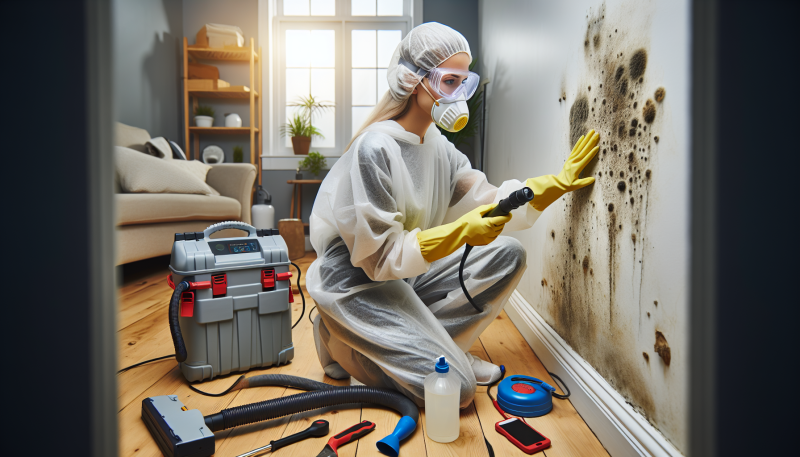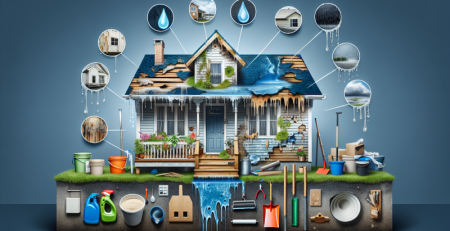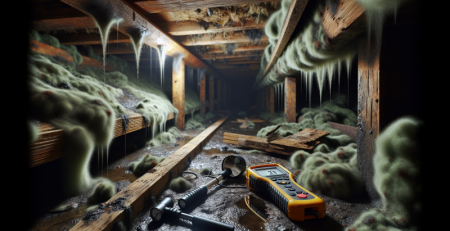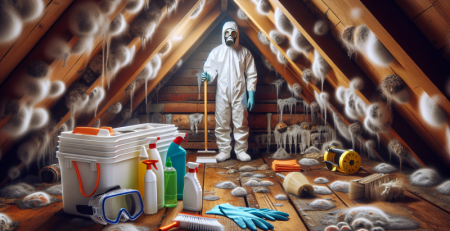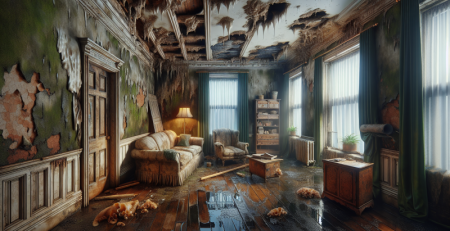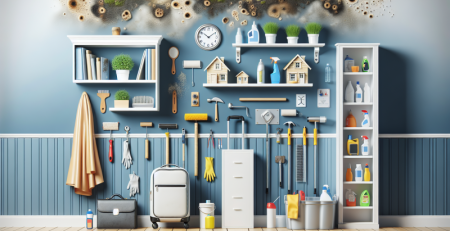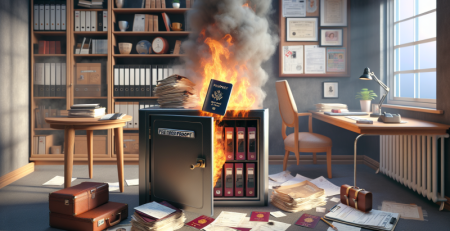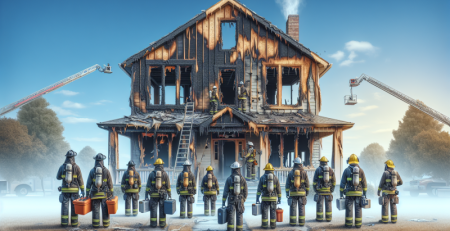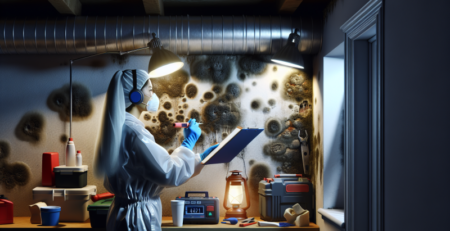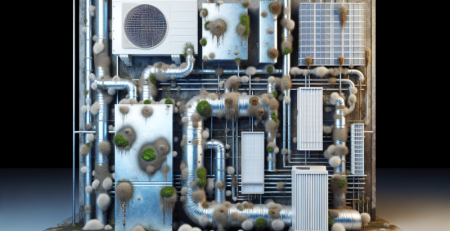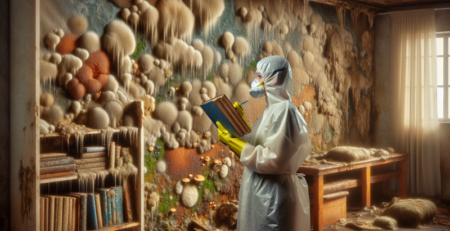Understanding the Mold Removal Process
Mold can be a serious issue for homeowners, posing health risks and damaging property. Understanding the mold removal process is essential for effectively tackling this problem and ensuring a safe living environment. At Kraus Restoration, NJ’s leaders in water, mold, and fire damage restoration, we specialize in providing comprehensive mold remediation services. Our IICRC certified experts are available 24/7, ready to respond rapidly to your mold emergencies. Serving Central and Northern NJ, we are committed to restoring your home to its pre-mold condition. In this blog, we will guide you through the essential steps of the mold removal process, helping you understand how to identify, contain, and eliminate mold effectively. If you suspect mold in your home, don’t hesitate to call us at (973) 886-2021 for immediate assistance.
The Importance of Mold Removal
Mold removal is a critical process that goes beyond mere aesthetics; it is essential for maintaining a healthy living environment. Mold can pose significant health risks, particularly to vulnerable populations such as children, the elderly, and individuals with pre-existing respiratory conditions. According to the Centers for Disease Control and Prevention (CDC), exposure to mold can lead to a variety of health issues, including allergic reactions, asthma attacks, and other respiratory problems. Therefore, understanding the importance of mold removal is vital for homeowners and property managers alike.
One of the primary reasons mold removal is crucial is its impact on indoor air quality. Mold spores can easily become airborne and circulate throughout a building, leading to widespread exposure. The World Health Organization (WHO) has reported that indoor air pollution, including mold, is a significant risk factor for respiratory diseases. By effectively removing mold, you can significantly improve the air quality in your home or business, creating a safer environment for everyone.
Moreover, mold can cause structural damage to buildings. It thrives in damp, humid conditions and can weaken the integrity of walls, ceilings, and floors. The longer mold is allowed to grow, the more extensive the damage can become, leading to costly repairs. According to a study by the National Association of Realtors, homes with mold issues can lose up to 30% of their value. This financial impact underscores the necessity of prompt mold remediation to protect your investment.
In addition to health and structural concerns, mold can also lead to unpleasant odors that can permeate a space. These odors are often a result of mold growth and can make a property uninviting. Removing mold not only eliminates the source of the smell but also restores a sense of cleanliness and comfort to your environment.
It is also important to note that mold removal is not just about cleaning visible mold. Effective mold remediation involves identifying and addressing the underlying moisture issues that allow mold to thrive. This may include repairing leaks, improving ventilation, and using dehumidifiers. According to the Environmental Protection Agency (EPA), controlling moisture is the key to preventing mold growth. Therefore, a comprehensive approach to mold removal is essential for long-term success.
When considering mold removal, it is advisable to seek professional help. Certified mold remediation specialists have the training and equipment necessary to safely and effectively remove mold. They can conduct thorough inspections, assess the extent of the mold problem, and implement appropriate remediation strategies. Attempting to remove mold without proper knowledge and equipment can lead to further contamination and health risks.
In conclusion, the importance of mold removal cannot be overstated. It is essential for protecting health, preserving property value, and ensuring a pleasant living environment. By understanding the risks associated with mold and taking proactive steps to remove it, homeowners and property managers can safeguard their spaces from the detrimental effects of mold growth. For more information on mold cleanup and the services available, visit our mold cleanup page or contact us to discuss your specific needs. Remember, addressing mold issues promptly can save you time, money, and health concerns in the long run.
For further reading on the health impacts of mold, you can refer to the CDC’s guidelines on mold and health. Additionally, the EPA provides valuable resources on preventing mold growth in homes. Understanding these aspects will empower you to take the necessary steps in maintaining a mold-free environment.
Identifying Mold: Signs and Symptoms
Mold can be a hidden menace in many homes and buildings, often thriving in damp, dark environments. Recognizing the signs and symptoms of mold is crucial for maintaining a healthy living space and preventing further complications. One of the most common indicators of mold presence is a musty odor. If you notice a persistent, earthy smell, it may be a sign that mold is growing in an unseen area, such as behind walls or under carpets. Additionally, visible signs of mold can manifest as dark spots or patches on surfaces, particularly in areas prone to moisture, like bathrooms, kitchens, and basements. These spots can vary in color, including black, green, or even white, and may appear fuzzy or slimy depending on the type of mold.
Another significant symptom to watch for is water damage. If you see discoloration on walls or ceilings, or if surfaces feel damp, it could indicate a leak or moisture problem that encourages mold growth. Furthermore, mold can have adverse effects on health, particularly for individuals with allergies or respiratory issues. Symptoms such as sneezing, coughing, skin irritation, or eye irritation can arise when mold spores are inhaled or come into contact with the skin. In more severe cases, prolonged exposure to mold can lead to serious health concerns, including respiratory infections or chronic lung conditions.
If you suspect mold in your home, it is essential to act quickly. You can start by inspecting areas that are commonly affected by moisture, such as around windows, under sinks, and in the corners of bathrooms. If you find mold or suspect its presence, it is advisable to consult professionals who specialize in mold cleanup. They can conduct a thorough assessment and provide the necessary remediation services to ensure your home is safe and healthy. Additionally, understanding the importance of proper ventilation and moisture control can help prevent mold from returning after it has been removed. Regular maintenance and monitoring of your home’s humidity levels can go a long way in keeping mold at bay. For more information on how to protect your home from mold and other environmental hazards, visit our about page or reach out through our contact page for expert advice and assistance.
The Mold Removal Process: Step-by-Step
Mold removal is a critical process that requires careful attention to detail and adherence to safety protocols. Understanding the mold removal process can help homeowners and property managers effectively address mold issues and prevent future growth. The first step in the mold removal process is to identify the source of moisture that is fueling mold growth. Mold thrives in damp environments, so it is essential to locate and eliminate any leaks or sources of humidity. This may involve inspecting plumbing, roofs, and basements, as well as checking for condensation issues. Once the moisture source is identified and resolved, the next step is to assess the extent of the mold contamination. This often involves a thorough inspection of the affected areas, including walls, ceilings, and hidden spaces like crawl spaces and attics. Professional mold remediation specialists may use specialized equipment to detect mold spores and assess the level of contamination.
After assessing the situation, the next phase is containment. It is crucial to prevent the spread of mold spores to unaffected areas of the property. This is typically achieved by sealing off the contaminated area with plastic sheeting and using negative air pressure machines to ensure that air does not escape into other parts of the building. Personal protective equipment, such as masks, gloves, and goggles, is also essential for anyone involved in the removal process to avoid exposure to harmful mold spores.
Once containment is established, the actual removal of mold can begin. This involves physically removing moldy materials, such as drywall, insulation, and carpeting, that cannot be cleaned effectively. For surfaces that can be cleaned, such as hard floors and non-porous surfaces, specialized cleaning solutions and techniques are employed to eliminate mold spores. It is important to follow industry guidelines during this process to ensure that all mold is removed and that the area is safe for reoccupation.
After the mold has been removed, the next step is to thoroughly dry the affected areas. This is a critical phase, as any remaining moisture can lead to mold returning. High-powered fans and dehumidifiers are often used to expedite the drying process. It is essential to monitor humidity levels and ensure that all materials are completely dry before proceeding to the next step.
Once the area is dry, it is advisable to apply a mold inhibitor to surfaces that were previously affected. This can help prevent future mold growth by creating a barrier against moisture. Additionally, it is important to address any underlying issues that contributed to the mold problem in the first place, such as improving ventilation or repairing leaks.
Finally, after the mold removal process is complete, a thorough inspection should be conducted to ensure that all mold has been effectively removed and that the area is safe for occupancy. This may involve air quality testing to confirm that mold spore levels are within acceptable limits. Homeowners and property managers should also consider implementing preventive measures, such as regular inspections and maintenance, to reduce the risk of mold returning.
In conclusion, understanding the mold removal process is essential for effectively addressing mold issues in any property. By following a systematic approach that includes moisture control, assessment, containment, removal, drying, and prevention, individuals can ensure a safe and healthy environment. For more information on mold cleanup services, you can visit our mold cleanup page. If you are facing a mold issue and need professional assistance, do not hesitate to contact us for expert help. Additionally, you can learn more about our comprehensive services to protect your property from mold and other hazards.
Safety Precautions During Mold Removal
Mold removal is a critical process that requires careful attention to safety precautions to protect both the individuals conducting the removal and the occupants of the affected area. Mold can pose serious health risks, including respiratory issues, allergic reactions, and other complications, particularly for those with pre-existing conditions. Therefore, understanding and implementing safety measures during mold remediation is essential for a successful and safe cleanup.
Before beginning the mold removal process, it is vital to assess the extent of the mold growth and determine the appropriate protective gear. Personal protective equipment (PPE) is a must. This typically includes N95 respirators or better, gloves, goggles, and protective clothing that can be discarded after the job is completed. The respirator protects against inhaling mold spores, while gloves and goggles prevent direct contact with mold, which can cause skin irritation and eye problems.
In addition to personal protective equipment, it is crucial to contain the mold-affected area to prevent spores from spreading to other parts of the building. This can be achieved by sealing off the area with plastic sheeting and using negative air pressure machines to filter the air. Proper containment not only protects the workers but also ensures that the mold does not migrate to unaffected areas, complicating the cleanup process.
Ventilation is another important aspect of safety during mold removal. While it may seem counterintuitive, proper ventilation helps to reduce the concentration of airborne mold spores. However, care must be taken to ensure that the ventilation does not allow spores to escape into other areas of the building. Using air scrubbers with HEPA filters can help to purify the air and minimize exposure to harmful spores.
It is also essential to be aware of the potential for mold-related health issues. Individuals with asthma, allergies, or weakened immune systems should avoid the mold removal area entirely. If possible, it is best to relocate occupants, especially vulnerable individuals, until the cleanup is complete. For those who must remain in the vicinity, ensuring they are equipped with appropriate PPE is crucial.
During the mold removal process, it is important to use the right cleaning agents and methods. Some cleaning solutions can be harmful if inhaled or if they come into contact with skin. Always read labels and follow manufacturer instructions carefully. Additionally, avoid using bleach for mold removal, as it can produce harmful fumes and may not effectively kill mold spores on porous surfaces.
After the mold has been removed, it is essential to properly dispose of contaminated materials. This includes any porous items that cannot be adequately cleaned, such as carpets, drywall, or insulation. These materials should be sealed in plastic bags before being removed from the site to prevent spores from escaping into the air.
Finally, once the mold removal is complete, it is crucial to take steps to prevent future mold growth. This includes addressing any moisture issues, such as leaks or high humidity, and ensuring proper ventilation in areas prone to dampness. Regular inspections and maintenance can help catch potential mold problems before they escalate.
In summary, safety precautions during mold removal are vital to protect the health of everyone involved and to ensure a thorough and effective cleanup. By using appropriate personal protective equipment, containing the affected area, ensuring proper ventilation, and following safe cleaning practices, the risks associated with mold can be significantly reduced. For more information on mold cleanup and other restoration services, visit mold cleanup or contact us at our contact page. Understanding these safety measures is an essential part of the mold removal process, ensuring a safe environment for both workers and residents alike.
Professional vs. DIY Mold Removal
When it comes to mold removal, homeowners often face the decision of whether to hire a professional service or tackle the problem themselves. Understanding the differences between professional mold removal and DIY methods is crucial for effective remediation and ensuring the safety of your home and family. Mold can pose serious health risks, and its removal requires careful consideration of various factors, including the extent of the infestation, the type of mold present, and the potential for future growth.
Professional mold removal services are equipped with the knowledge, tools, and experience necessary to handle mold infestations safely and effectively. These experts conduct thorough inspections to assess the extent of the mold problem, identifying hidden mold that may not be visible to the untrained eye. They utilize specialized equipment, such as air scrubbers and dehumidifiers, to contain and remove mold spores from the environment. Additionally, professionals follow strict safety protocols to protect themselves and the occupants of the home from exposure to harmful mold.
One of the significant advantages of hiring professionals is their ability to address the root cause of the mold growth. Mold thrives in damp, humid conditions, and simply removing the visible mold does not solve the underlying issue. Professionals can identify sources of moisture, such as leaks or poor ventilation, and recommend appropriate solutions to prevent future mold growth. This comprehensive approach not only ensures that the current mold problem is resolved but also helps safeguard against future infestations.
On the other hand, some homeowners may consider DIY mold removal as a cost-effective alternative. While it is possible to remove small patches of mold using household cleaning products, this approach has its limitations. DIY methods may not be sufficient for larger infestations or for certain types of mold that require specialized treatment. Moreover, without proper protective gear and knowledge of safe removal techniques, homeowners risk exposing themselves to harmful spores during the cleanup process.
Another critical aspect to consider is the potential for cross-contamination. Inadequate containment measures during DIY mold removal can lead to mold spores spreading to other areas of the home, exacerbating the problem. Professionals are trained to implement containment strategies that minimize the risk of cross-contamination, ensuring that the mold is removed effectively without spreading it further.
Cost is often a significant factor in the decision-making process. While DIY mold removal may seem less expensive initially, it can lead to higher costs in the long run if the problem is not adequately addressed. If mold returns due to improper removal or failure to address underlying moisture issues, homeowners may find themselves facing more extensive damage and higher remediation costs. In contrast, professional services may involve a higher upfront investment, but they often provide long-term solutions that can save homeowners money and stress over time.
In conclusion, the choice between professional mold removal and DIY methods depends on various factors, including the severity of the mold problem, the homeowner’s experience and comfort level with mold remediation, and the potential health risks involved. For minor mold issues, DIY methods may suffice, but for larger infestations or when health concerns are present, it is advisable to seek the expertise of professionals. By understanding the mold removal process and the benefits of professional services, homeowners can make informed decisions that protect their health and property. If you are facing a mold issue, consider reaching out to experts for a thorough assessment and effective remediation. For more information about our mold cleanup services or to learn about our company, please visit our website. If you have any questions or need assistance, do not hesitate to contact us.
Preventing Future Mold Growth
After successfully removing mold from your home or business, it is crucial to take proactive steps to prevent its return. Mold thrives in damp, humid environments, so controlling moisture is the first line of defense. Start by identifying and addressing any sources of water intrusion, such as leaky roofs, plumbing issues, or poor drainage systems. Regularly inspect your property for signs of water damage, and ensure that gutters and downspouts direct water away from the foundation.
Ventilation plays a significant role in mold prevention. Ensure that areas prone to moisture, such as bathrooms, kitchens, and basements, are well-ventilated. Installing exhaust fans can help reduce humidity levels, especially during activities that generate moisture, like cooking or showering. Additionally, consider using dehumidifiers in areas with high humidity to maintain optimal moisture levels. Keeping indoor humidity below 60 percent is ideal for preventing mold growth.
Another effective strategy is to use mold-resistant products during renovations or repairs. Mold-resistant drywall, paints, and insulation can significantly reduce the likelihood of mold colonization. If you are planning a renovation, consider consulting with professionals who specialize in mold cleanup to ensure that your materials and methods are conducive to a mold-free environment.
Regular cleaning and maintenance are also essential in preventing mold growth. Pay special attention to areas that are often overlooked, such as behind appliances, under sinks, and in corners. Use mold-inhibiting cleaning solutions to wipe down surfaces, especially in areas prone to moisture. Additionally, keep an eye on your HVAC system; changing filters regularly and having the system serviced can help reduce humidity and prevent mold spores from circulating throughout your home.
If you live in a flood-prone area or have experienced water damage in the past, it is wise to have a plan in place for quick response. Familiarize yourself with local restoration services that specialize in water cleanup to ensure that you can act swiftly in the event of a leak or flood. The faster you can address water issues, the less likely mold will have a chance to establish itself.
Educating yourself and your family or employees about mold and its prevention is also a key aspect of maintaining a mold-free environment. Understanding the conditions that promote mold growth can help everyone take the necessary precautions. Encourage regular checks for moisture and leaks, and foster a culture of cleanliness and vigilance.
Lastly, consider the landscaping around your property. Ensure that soil is graded away from the foundation to prevent water pooling. Planting vegetation that requires less water can also help maintain lower moisture levels around your home. If you have a sprinkler system, make sure it is not overwatering areas close to the foundation.
By implementing these strategies, you can significantly reduce the risk of future mold growth in your home or business. Taking a proactive approach not only protects your property but also contributes to a healthier indoor environment. If you need assistance or further information on mold prevention, do not hesitate to reach out through our contact page. Our team is here to help you maintain a safe and mold-free space.
When to Seek Professional Help
Understanding when to seek professional help in the mold removal process is crucial for maintaining a healthy living environment. Mold can pose serious health risks, especially for individuals with respiratory issues, allergies, or weakened immune systems. If you notice signs of mold growth in your home, such as a musty odor, visible mold patches, or water damage, it is essential to assess the situation carefully.
If the affected area is larger than ten square feet, it is advisable to contact a professional mold remediation service. Mold can spread quickly, and a small problem can escalate into a significant issue if not addressed promptly. Professionals have the expertise and equipment to handle extensive mold infestations safely and effectively. They can identify the source of moisture that is allowing the mold to thrive and implement solutions to prevent future growth.
Another critical factor to consider is the type of mold present. Some mold species can be toxic, such as black mold (Stachybotrys chartarum). If you suspect the presence of toxic mold or if you experience health symptoms like coughing, sneezing, or skin irritation, it is vital to seek professional help immediately. Professionals can conduct mold testing to determine the type of mold and the appropriate remediation steps.
Additionally, if you have attempted to remove mold yourself but the problem persists or worsens, it is time to call in the experts. DIY methods may not be sufficient for eliminating mold, especially if the underlying moisture issue is not resolved. Professionals can provide a comprehensive assessment and ensure that the mold is removed entirely, preventing recurrence.
In cases where mold is located in hard-to-reach areas, such as behind walls or under flooring, professional assistance is necessary. Mold can thrive in hidden spaces, and without proper equipment and expertise, it can be challenging to eliminate it completely. Professionals use specialized tools and techniques to access these areas safely and effectively.
If you are unsure about the extent of the mold problem or how to proceed, consulting with a professional can provide peace of mind. They can offer guidance on the best course of action, whether it involves remediation, repairs, or preventive measures.
Furthermore, if your property has experienced significant water damage due to flooding or leaks, it is crucial to seek professional help promptly. Mold can begin to grow within 24 to 48 hours of water exposure, making quick action essential. Professionals specializing in water cleanup can address the moisture issue and mitigate the risk of mold growth.
In summary, knowing when to seek professional help in the mold removal process is vital for ensuring a safe and healthy environment. If you encounter extensive mold growth, suspect toxic mold, struggle with persistent mold issues, or deal with hidden mold, it is best to consult with experts. They can provide the necessary resources and knowledge to effectively manage mold problems and restore your home. For more information on our services, visit our services page or contact us for assistance. Your health and safety should always come first, and professional help can make all the difference in effectively addressing mold concerns.
In conclusion, understanding the mold removal process is essential for maintaining a healthy living environment. Mold can pose serious health risks and cause significant damage to your property if left untreated. By familiarizing yourself with the steps involved—ranging from identifying the source of moisture to safely removing the mold and preventing future growth—you can take proactive measures to protect your home and your health. Whether you choose to tackle the problem yourself or enlist the help of professionals, being informed empowers you to make the best decisions for your situation. Remember, the key to effective mold removal lies not just in addressing the visible signs but also in understanding the underlying causes and implementing long-term solutions. Stay vigilant, act promptly, and ensure your space remains mold-free for years to come.
